- Home
- Oliver Sacks
The River of Consciousness
The River of Consciousness Read online
ALSO BY OLIVER SACKS
Migraine
Awakenings
A Leg to Stand On
The Man Who Mistook His Wife for a Hat
Seeing Voices
An Anthropologist on Mars
The Island of the Colorblind
Uncle Tungsten
Oaxaca Journal
Musicophilia
The Mind’s Eye
Hallucinations
On the Move
Gratitude
THIS IS A BORZOI BOOK PUBLISHED BY ALFRED A. KNOPF AND ALFRED A. KNOPF CANADA
Copyright © 2017 by the Oliver Sacks Foundation
All rights reserved. Published in the United States by Alfred A. Knopf, a division of Penguin Random House LLC, New York, and in Canada by Alfred A. Knopf Canada, a division of Penguin Random House Canada Limited, Toronto.
www.aaknopf.com
www.penguinrandomhouse.ca
www.oliversacks.com
Knopf, Borzoi Books, and the colophon are registered trademarks of Penguin Random House LLC. Knopf Canada and colophon are trademarks of Penguin Random House Canada Ltd.
Library of Congress Cataloging-in-Publication Data
Names: Sacks, Oliver, 1933–2015.
Title: The river of consciousness / by Oliver Sacks.
Description: New York : Alfred A. Knopf, 2017. | “A Borzoi book.” | Includes bibliographical references and index.
Identifiers: LCCN 2017000815 (print) | LCCN 2017001699 (ebook) | ISBN 9780385352567 (hardcover : alk. paper) | ISBN 9780385352574 (ebook)
Subjects: LCSH: Consciousness. | Neuropsychology. | Creative ability.
Classification: LCC QP411 .S23 2017 (print) | LCC QP411 (ebook) | DDC 612.8/233—dc23
LC record available at https://lccn.loc.gov/2017000815
Library and Archives Canada Cataloguing in Publication
Sacks, Oliver, 1933–2015, author
The river of consciousness / Oliver Sacks.
Issued in print and electronic formats.
ISBN 978-0-345-80899-8
eBook ISBN 978-0-345-80901-8
1. Consciousness. 2. Neuropsychology. 3. Creative ability. I. Title.
QP411.S23 2017 612.8'233 C2017-901520-6
Ebook ISBN 9780385352574
Cover image: L’Eure à Pacy-sur-Eure by Félix Vallotton, 1924. akg-images
Cover design by Carol Devine Carson
v4.1
ep
Contents
Cover
Also by Oliver Sacks
Title Page
Copyright
Dedication
Foreword
Darwin and the Meaning of Flowers
Speed
Sentience: The Mental Lives of Plants and Worms
The Other Road: Freud as Neurologist
The Fallibility of Memory
Mishearings
The Creative Self
A General Feeling of Disorder
The River of Consciousness
Scotoma: Forgetting and Neglect in Science
Bibliography
A Note About the Author
For Bob Silvers
Foreword
Two weeks before his death in August 2015, Oliver Sacks outlined the contents of The River of Consciousness, the last book he would oversee, and charged the three of us with arranging its publication.
One of many catalysts for this book was an invitation Sacks received in 1991 from a Dutch filmmaker to participate in a documentary television series called A Glorious Accident. In the final episode, six scientists—the physicist Freeman Dyson, the biologist Rupert Sheldrake, the paleontologist Stephen Jay Gould, the historian of science Stephen Toulmin, the philosopher Daniel Dennett, and Dr. Sacks—gathered around a table to discuss some of the most important questions that scientists investigate: the origin of life, the meaning of evolution, the nature of consciousness. In a lively discussion, one thing was clear: Sacks could move fluidly among all of the disciplines. His grasp of science was not restricted to neuroscience or medicine; the issues, ideas, and questions of all the sciences enthused him. That wide-ranging expertise and passion informs the perspective of this book, in which he interrogates the nature not only of human experience but of all life (including botanical life).
In The River of Consciousness, he takes on evolution, botany, chemistry, medicine, neuroscience, and the arts, and calls upon his great scientific and creative heroes—above all, Darwin, Freud, and William James. For Sacks, these writers were constant companions from an early age, and much of his own work can be seen as an extended conversation with them. Like Darwin, he was an acute observer and delighted in collecting examples, many of which came from his massive correspondence with patients and colleagues. Like Freud, he was drawn to understand human behavior at its most enigmatic. And like James, even when Sacks’s subject is theoretical, as in his investigations of time, memory, and creativity, his attention remains on the specificity of experience.
Dr. Sacks wished to dedicate this book to his editor, mentor, and friend of more than thirty years, Robert Silvers, who first published a number of the pieces gathered here in The New York Review of Books.
—Kate Edgar, Daniel Frank, and Bill Hayes
Darwin and the Meaning of Flowers
We all know the canonical story of Charles Darwin: the twenty-two-year-old embarking on the Beagle, going to the ends of the earth; Darwin in Patagonia; Darwin on the Argentine pampas (managing to lasso the legs of his own horse); Darwin in South America, collecting the bones of giant extinct animals; Darwin in Australia—still a religious believer—startled at his first sight of a kangaroo (“surely two distinct Creators must have been at work”). And, of course, Darwin in the Galápagos, observing how the finches were different on each island, starting to experience the seismic shift in understanding how living things evolve that, a quarter of a century later, would result in the publication of On the Origin of Species.
The story climaxes here, with the publication of the Origin in November 1859, and has a sort of elegiac postscript: a vision of the older and ailing Darwin, in the twenty-odd years remaining to him, pottering around his gardens at Down House with no particular plan or purpose, perhaps throwing off a book or two, but with his major work long completed.
Nothing could be further from the truth. Darwin remained intensely sensitive both to criticisms and to evidence supporting his theory of natural selection, and this led him to bring out no fewer than five editions of the Origin. He might indeed have retreated (or returned) to his garden and his greenhouses after 1859 (there were extensive grounds around Down House, and five greenhouses), but for him these became engines of war, from which he would lob great missiles of evidence at the skeptics outside—descriptions of extraordinary structures and behaviors in plants very difficult to ascribe to special creation or design—a mass of evidence for evolution and natural selection even more overwhelming than that presented in the Origin.
Strangely, even Darwin scholars pay relatively little attention to this botanical work, even though it encompassed six books and seventy-odd papers. Thus Duane Isely, in his 1994 book, One Hundred and One Botanists, writes that while
more has been written about Darwin than any other biologist who ever lived…[he] is rarely presented as a botanist….The fact that he wrote several books about his research on plants is mentioned in much Darwinia, but it is casual, somewhat in the light of “Well, the great man needs to play now and then.”
Darwin had always had a special, tender feeling for plants and a special admiration, too. (“It has always pleased me to exalt plants in the scale of organised beings,” he wrote in his autobiography.) He grew up in a botanical family—his grandfather Er
asmus Darwin had written a long, two-volume poem called The Botanic Garden, and Charles himself grew up in a house whose extensive gardens were filled not only with flowers but with a variety of apple trees crossbred for increased vigor. As a university student at Cambridge, the only lectures Darwin consistently attended were those of the botanist J. S. Henslow, and it was Henslow, recognizing the extraordinary qualities of his student, who recommended him for a position on the Beagle.
It was to Henslow that Darwin wrote very detailed letters full of observations about the fauna and flora and geology of the places he visited. (These letters, when printed and circulated, were to make Darwin famous in scientific circles even before the Beagle returned to England.) And it was for Henslow that Darwin, in the Galápagos, made a careful collection of all the plants in flower and noted how different islands in the archipelago could often have different species of the same genus. This was to become a crucial piece of evidence for him as he thought about the role of geographical divergence in the origin of new species.
Indeed, as David Kohn pointed out in a splendid 2008 essay, Darwin’s Galápagos plant specimens, numbering well over two hundred, constituted “the single most influential natural history collection of live organisms in the entire history of science….They also would turn out to be Darwin’s best documented example of the evolution of species on the islands.”
(The birds Darwin collected, by contrast, were not always correctly identified or labeled with their island of origin, and it was only on his return to England that these, supplemented by the specimens collected by his shipmates, were sorted out by the ornithologist John Gould.)
Darwin became close friends with two botanists, Joseph Dalton Hooker at Kew Gardens and Asa Gray at Harvard. Hooker had become his confidant in the 1840s—the only man to whom he showed the first draft of his work on evolution—and Asa Gray was to join the inner circle in the 1850s. Darwin would write to them both with increasing enthusiasm about “our theory.”
Yet though Darwin was happy to call himself a geologist (he wrote three geological books based on his observations during the voyage of the Beagle and conceived a strikingly original theory on the origin of coral atolls, which was confirmed experimentally only in the second half of the twentieth century), he always insisted that he was not a botanist. One reason was that botany had (despite a precocious start in the early eighteenth century with Stephen Hales’s Vegetable Staticks, a book full of fascinating experiments on plant physiology) remained almost entirely a descriptive and taxonomic discipline: plants were identified, classified, and named but not investigated. Darwin, by contrast, was preeminently an investigator, concerned with the “how” and “why” of plant structure and behavior, not just the “what.”
Botany was not a mere avocation or hobby for Darwin, as it was for so many in the Victorian age; the study of plants was always infused for him with theoretical purpose, and the theoretical purpose had to do with evolution and natural selection. It was, as his son Francis wrote, “as though he were charged with theorising power ready to flow into any channel on the slightest disturbance, so that no fact, however small, could avoid releasing a stream of theory.” And the flow went both ways; Darwin himself often said that “no one could be a good observer unless he was an active theoriser.”
In the eighteenth century, the Swedish scientist Carl Linnaeus had shown that flowers had sexual organs (pistils and stamens), and indeed had based his classifications on these. But it was almost universally believed that flowers were self-fertilized—why else would each flower contain both male and female organs? Linnaeus himself made merry with the idea, portraying a flower with nine stamens and one pistil as a bedchamber in which a maiden was surrounded by nine lovers. A similar conceit appeared in the second volume of Darwin’s grandfather’s book The Botanic Garden, titled The Loves of the Plants. This was the atmosphere in which the younger Darwin grew up.
But within a year or two of his return from the Beagle, Darwin felt forced, on theoretical grounds, to question the idea of self-fertilization. In an 1837 notebook, he wrote, “Do not plants which have male and female organs together yet receive influence from other plants?” If plants were ever to evolve, he reasoned, cross-fertilization was crucial—otherwise, no modifications could ever occur, and the world would be stuck with a single, self-reproducing plant instead of the extraordinary range of species it actually had. In the early 1840s, Darwin started to test his theory, dissecting a variety of flowers (azaleas and rhododendrons among them) and demonstrating that many of these had structural devices for preventing or minimizing self-pollination.
But it was only after On the Origin of Species was published in 1859 that Darwin could turn his full attention to plants. And where his early work was primarily as an observer and a collector, experiments now became his chief way of obtaining new knowledge.
He had observed, as others had, that primrose flowers came in two different forms: a “pin” form with a long style—the female part of the flower—and a “thrum” form with a short style. These differences were thought to have no particular significance. But Darwin suspected otherwise, and examining bunches of primroses that his children brought him, he found that the ratio of pins to thrums was exactly one to one.
Darwin’s imagination was instantly aroused: a one-to-one ratio was what one might expect of species with separate males and females—could it be that the long-styled flowers, though hermaphrodites, were in the process of becoming female flowers and the short-styled ones male flowers? Was he actually seeing intermediate forms, evolution in action? It was a lovely idea, but it did not hold up, for the short-styled flowers, the putative males, produced as much seed as the long-styled, “female” ones. Here (as his friend T. H. Huxley would have put it) was “the slaying of a beautiful hypothesis by an ugly fact.”
What, then, was the meaning of these different styles and their one-to-one ratio? Giving up theorizing, Darwin turned to experiment. Painstakingly, he tried acting as a pollinator himself, lying facedown on the lawn and transferring pollen from flower to flower: long-styled to long-styled, short-styled to short-styled, long-styled to short-styled, and vice versa. When seeds were produced, he collected and weighed them and found that the richest crop of seeds came from the crossbred flowers. He concluded that heterostyly, in which plants have styles of different length, was a special device that had evolved to facilitate outbreeding and that crossing increased the number and vitality of seeds (he called this “hybrid vigour”). Darwin later wrote, “I do not think anything in my scientific life has given me so much satisfaction as making out the meaning of the structure of these plants.”
Although this subject remained a special interest of Darwin’s (he published a book on it in 1877, The Different Forms of Flowers on Plants of the Same Species), his central concern was how flowering plants adapted themselves to using insects as agents for their own fertilization. It was well known that insects were attracted to certain flowers, visited them, and could emerge from blossoms covered with pollen. But no one had thought this was of much importance, since it was assumed that flowers were self-pollinated.
Darwin had already become suspicious of this by 1840, and in the 1850s he set five of his children to work plotting the flight routes of male humble bees. He especially admired the native orchids that grew in the meadows around Down, so he started with those. Then, with the help of friends and correspondents who sent him orchids to study, and especially Hooker, who was now director of Kew Gardens, he extended his studies to tropical orchids of all kinds.
The orchid work moved quickly and well, and in 1862 Darwin was able to send his manuscript to the printers. The book had a typically long and explicit Victorian title, On the Various Contrivances by Which British and Foreign Orchids Are Fertilised by Insects. His intentions, or hopes, were made clear in its opening pages:
In my volume “On the Origin of Species” I gave only general reasons for the belief that it is an almost universal law of nature that the higher or
ganic beings require an occasional cross with another individual….I wish here to show that I have not spoken without having gone into details….This treatise affords me also an opportunity of attempting to show that the study of organic beings may be as interesting to an observer who is fully convinced that the structure of each is due to secondary laws, as to one who views every trifling detail of structure as the result of the direct interposition of the Creator.
Here, in no uncertain terms, Darwin is throwing down the gauntlet, saying, “Explain that better—if you can.”
Darwin interrogated orchids, interrogated flowers, as no one had ever done before, and in his orchid book he provided enormous detail, far more than is to be found in the Origin. This was not because he was pedantic or obsessional but because he felt that every detail was potentially significant. It is sometimes said that God is in the details, but for Darwin it was not God but natural selection, acting over millions of years, which shone out from the details, details that were unintelligible, senseless, except in the light of history and evolution. His botanical researches, his son Francis wrote,
supplied an argument against those critics who have so freely dogmatised as to the uselessness of particular structures, and as to the consequent impossibility of their having been developed by means of natural selection. His observations on Orchids enabled him to say: “I can show the meaning of some of the apparently meaningless ridges and horns; who will now venture to say that this or that structure is useless?”
In a 1793 book titled The Secret of Nature in the Form and Fertilization of Flowers Discovered, the German botanist Christian Konrad Sprengel, a most careful observer, had noted that bees laden with pollen would carry it from one flower to another. Darwin always called this a “wonderful” book. But Sprengel, though he drew close, missed the final secret, because he was still wedded to the Linnaean idea of flowers as self-fertilizing and thought of flowers of the same species as essentially identical. It was here that Darwin made a radical break and cracked the secret of flowers, by showing that their special features—the various patterns, colors, shapes, nectars, and scents by which they lured insects to flit from one plant to another, and the devices which ensured that the insects would pick up pollen before they left the flower—were all “contrivances,” as he put it; they had all evolved in the service of cross-fertilization.

 Uncle Tungsten
Uncle Tungsten Oaxaca Journal
Oaxaca Journal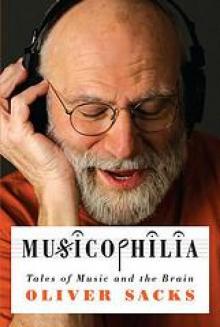 Musicophilia
Musicophilia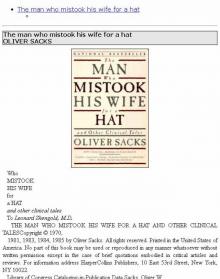 The man who mistook his wife for a hat
The man who mistook his wife for a hat 1989 - Seeing Voices
1989 - Seeing Voices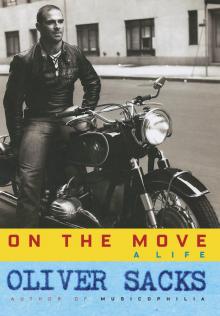 On the Move: A Life
On the Move: A Life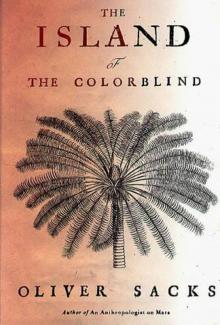 1996 - The Island of the Colorblind
1996 - The Island of the Colorblind An Anthropologist on Mars: Seven Paradoxical Tales
An Anthropologist on Mars: Seven Paradoxical Tales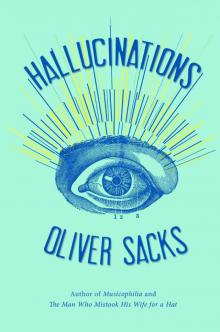 Hallucinations
Hallucinations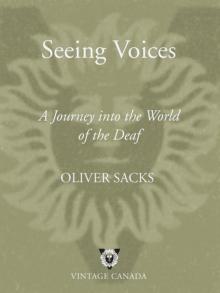 Seeing Voices
Seeing Voices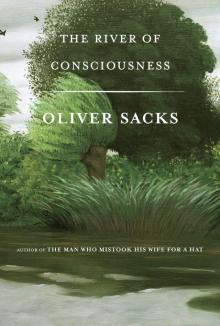 The River of Consciousness
The River of Consciousness Vintage Sacks
Vintage Sacks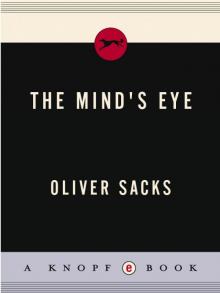 The Mind's Eye
The Mind's Eye Everything in Its Place
Everything in Its Place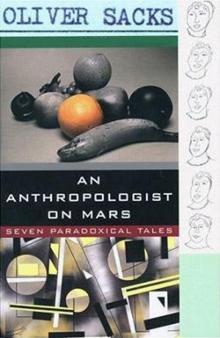 An Anthropologist on Mars (1995)
An Anthropologist on Mars (1995) Uncle Tungsten: Memories of a Chemical Boyhood (2001)
Uncle Tungsten: Memories of a Chemical Boyhood (2001)